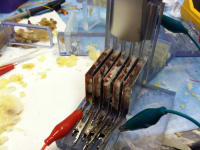Change in the cell and tissue structure of a Zinc/Copper Potato Cell by means of boiling and irreversible electroporation was found to increase the power generated by the cell[1]. This breakthrough is important in the field of reversible and sustainable energy and more importantly for disadvantage communities who lack the necessary
resources to produce electricity.
Tests that were conducted demonstrated that treated potatoes had a higher voltage and current than untreated potatoes [1]. Which can be related to the impedance created by the KCL salt bridge made of Zinc, Copper, electrolysis and potato tissue, which is the dominating factor in how much energy the different treated potatoes produced. The electrical energy generated was directly linked to the destruction of the cell membranes allowing for “ionic diffusivity through the tissue bridge between electrons” [1].
A battery is a chemical reaction that occurs where one side of the battery releases electrons while the other accepts them [2]. This transferring of electrons is what produces current. Where the current can be extracted from the battery and produce a source of energy. The positive and negative electrodes along with the active materials which is stored in the electrodes is what makes up the overall chemical reaction. The oxidizing substance, releaser of electrons, is contained within the electrode during the discharge of the battery and the positive electrode contains the oxidizing substance that is reduced. The total amount of energy that can be produced from each cell is the difference in boding energy at the beginning and final parts of the reaction.
The Zn/Cu Potato Battery prototype we have created can easily be used by anyone in a third world country to produce sufficient and long lasting reading light. The person can simply place their boiled potato in between the two plastic walls and slide it into the copper and zinc plates in one motion. Not only only do the zinc and copper plates produce a reaction with the potato but they also cut the potato into place and the slider removes excess potato from the top. There are already plastic squares that separate the zinc and copper plates to prevent the short circuit of the potato. After the person is done with this first simple step they use the second piece to push the potatoes in further and increase the amount of voltage produced by the battery. This device was also made to be easy to take apart and clean. In our test we measured 4.9 V which provided sufficient amount of reading light in a completely dark room. Additionally this technology can also be used for small medical devices. The materials we used were polycarbonate and zinc and copper plates.
Sources
[1] Alex Golberg, Zn/Cu-vegetative batteries, bioelectrical characterizations, and primary
cost analyses. Journal of Renewable and Sustainable Energy, (2010)
[2] D. BERNDT, Electrochemical Energy Storage. (Expert Verlag, 2003)
Like this entry?
-
About the Entrant
- Name:Xochitl Garcia
- Type of entry:teamTeam members:Alex Goldbeg,Post-Doc
- Patent status:none








